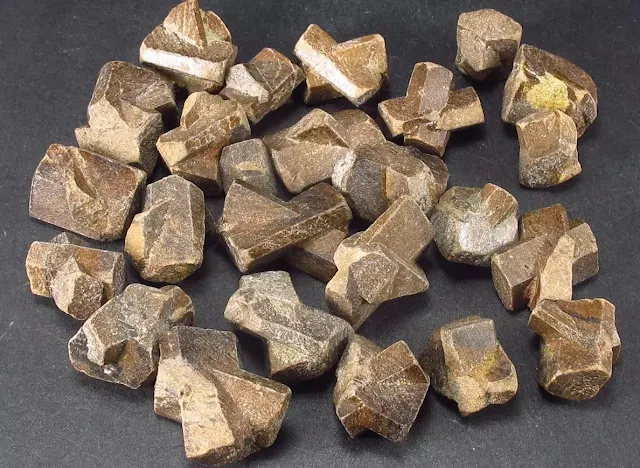Gemstones Found in Metamorphic Rocks
Metamorphic rocks can be a treasure trove for some of the most beautiful and valuable gemstones on Earth. Examples of gems commonly found in metamorphic rocks include garnet, ruby, sapphire, jade, kyanite, and staurolite.
What are metamorphic rocks?
Metamorphic rocks are rocks formed by the transformation of pre-existing rocks under high pressure, high temperature, or a combination of both. This transformation process, called metamorphism, occurs in the solid state, meaning the rocks don't melt but rather recrystallize into a new rock with distinct characteristics.
Metamorphic rocks are categorized into two main groups: Foliated: These have a banded or layered appearance due to the parallel alignment of platy or elongated minerals. Examples include slate, phyllite, schist, and gneiss. Non-foliated: These lack a banded appearance and exhibit massive, granular, or even glassy textures. Examples include marble, quartzite, and soapstone.
The minerals found in metamorphic rocks depend heavily on the composition of the original rock. Metamorphic rocks are widespread and play a crucial role in the rock cycle. They are used in various applications like construction materials, countertops, and sculptures.
 |
| Gemstones Found in Metamorphic Rocks |
How do gems form in metamorphic rocks?
Gems can form in metamorphic rocks through various processes, including:
Metasomatism
Metamorphism can sometimes be accompanied by hydrothermal activity, where hot, mineral-rich fluids circulate through the rocks. These fluids can dissolve existing minerals and redeposit them in fractures or cavities, potentially leading to the formation of gem crystals.
For example, ruby and sapphire formation can occur in metamorphic rocks when aluminum-rich fluids interact with chromium impurities, leading to the characteristic red color of ruby.
Recrystallization
During metamorphism, the intense pressure forces minerals within the original rock (protolith) to become unstable and recrystallize. This process can concentrate existing elements or create new mineral assemblages, potentially leading to gem formation. Existing minerals recrystallize into new gem minerals, such as garnet, staurolite, or kyanite, due to changes in pressure and temperature.
Metamorphic differentiation
This process refers to the segregation and concentration of minerals within a metamorphic rock under extreme pressure. Quartz, a versatile and beautiful gemstone, and feldspar, a cornerstone of many gem varieties, can be concentrated through metamorphic differentiation.
Pegmatitic activity
The realm of gem formation in metamorphic rocks extends beyond purely metamorphic processes. In some instances, these rocks encounter magma, molten rock material originating from deep within the Earth. When these hot, mineral-rich fluids interact with the metamorphic rocks, a new process unfolds, termed pegmatitic activity. This interaction can introduce rare elements not typically found in the metamorphic environment. These elements can then combine to form a unique class of gems known as pegmatites. Beryl, the mineral family that includes the captivating emerald and the cool aquamarine, can be a product of pegmatitic activity within metamorphic rocks. Topaz, known for its fiery brilliance, and tourmaline, with its vast array of colors, can also be traced back to this fascinating interaction.
These processes occur under high pressure and temperature conditions, resulting in the formation of unique and beautiful gemstones.
Examples of gems found in metamorphic rocks
Metamorphic rocks can host a variety of gem-quality minerals due to the high-pressure and high-temperature environments that cause their formation. Some of the most popular and valuable gems can be found in metamorphic rocks.
Garnet
Garnets are a group of minerals known for their durability and come in a variety of colors like red, orange, green, and purple. Their formation in metamorphic rocks is primarily driven by
recrystallization. The intense pressure concentrates elements like aluminum, iron, magnesium, and calcium, allowing them to combine and form various garnet species. Garnets are found in a wide range of metamorphic rocks including schist, gneiss, and marble. Metamorphic rocks can be a rich source for various garnet species. The intense pressure facilitates the concentration of elements like aluminum (Al), iron (Fe), magnesium (Mg), and calcium (Ca). These elements can combine to form different garnet species, each with a distinct chemical formula and color spectrum. Examples include almandine (red), pyrope (red), spessartine (orange), and grossularite (colorless, green, or yellow).
Jade
This gemstone, synonymous with Asian cultures. There are two types of jade, nephrite and jadeite. Nephrite is a calcium magnesium silicate, while jadeite is a sodium aluminum silicate. Both types of jade are valued for their toughness and attractive green color. Metamorphic processes, particularly metasomatism, can alter ultramafic rocks (rich in magnesium and iron) to form jade. Jade is found in a variety of metamorphic rocks, including serpentinite and eclogite, which are formed under specific pressure and temperature regimes.
Rubies and Sapphires
These are both varieties of the mineral corundum. Ruby exhibits a red color due to the presence of chromium, while sapphire can exhibit a variety of colors including blue, yellow, green, or pink depending on trace element impurities. Rubies are red, while sapphires can be blue, yellow, green, or orange. These gems are found in marbles and other metamorphic rocks that have undergone high-pressure and high-temperature metamorphism, conditions that promote the growth of large, well-formed crystals.
Kyanite
Kyanite, known for its blade-like crystals and beautiful blue color, is primarily a product of recrystallization, often found in metamorphic rocks like schist, gneiss, and eclogite. Kyanite's hardness and excellent cleavage, the tendency to break along specific planes, make it valuable in two applications: gemstones and industrial abrasives. In the realm of gemstones, kyanite's unique chatoyancy, a cat's-eye effect, can be a sought-after feature, particularly in cabochon cuts.
 |
| Staurolite |
Staurolite
Staurolite is a nesosilicate mineral. It is commonly found in metamorphic rocks like schist and gneiss. Cruciform Twins: Staurolite most distinctive feature is its tendency to form brown or black crystals that frequently twin at nearly 90 degrees, resembling a cross. This characteristic formation is the reason for its name, "staurolite" derived from the Greek word for "cross-stone."
Staurolite, while not as widely prized as some other metamorphic gems, is valued for its unique cruciform crystal habit and can be a beautiful addition to a collection or used in certain types of jewelry.
Tourmaline
Tourmaline is a highly prized gemstone due to its exceptional durability and the remarkable range of colors it exhibits, including pink, red, green, blue, black, and even watermelon tourmaline (a combination of pink and green). Tourmaline can be found in various geological environments, including metamorphic rocks like marble and schist.
Zoisite
This calcium aluminum silicate mineral can occur in various colors, including green, yellow, brown, and pink. In some instances, it can be used as a diamond simulant due to its resemblance. Zoisite formation in metamorphic rocks is primarily linked to metasomatic processes, where mineral-rich fluids introduce new elements, potentially leading to the formation of zoisite.
Beryl
While more commonly found in igneous rocks, beryl (beryllium aluminum silicate) can sometimes occur in specific metamorphic environments. This mineral family includes emeralds (green due to chromium impurities) and aquamarines (blue due to iron impurities).
Spinel
Spinel is another mineral that is more commonly found in igneous rocks, but it can also be found in some metamorphic rocks, particularly those that have been subjected to high temperatures. This magnesium aluminum oxide gem can come in a variety of colors, including red, blue, green, and yellow. Due to its color variations, spinel can sometimes be mistaken for ruby or sapphire.
These are just a few examples, and the list of metamorphic gems extends further. It's important to note that not all metamorphic rocks contain gems. However, the unique geological conditions they experience can create a favorable environment for the formation of some truly exceptional gemstones.
Conclusion
In conclusion, metamorphic rocks can be a significant source for the global gem industry. The intense pressure and heat that create these rocks can transform them into a treasure trove for a variety of captivating gemstones, each with its own unique story to tell.
Read also:
What Gemstones Can Be Found in Sedimentary Rocks
What Gems Are Found in Igneous Rock


%20(1).webp)





